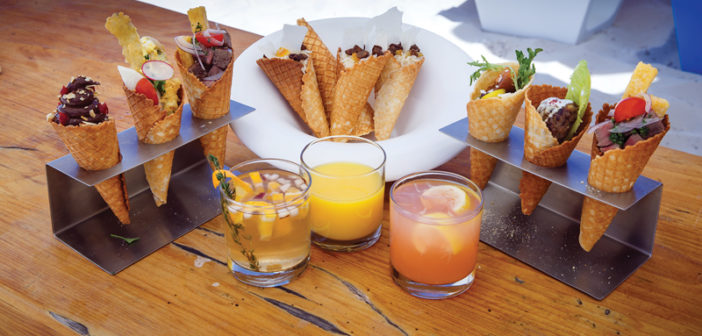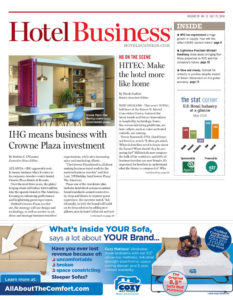
Grace Bay Club’s pop-up restaurant, Kone, serves contemporary Caribbean cuisine and combinations of fresh fish such as Turks & Caicos lobster or spicy ahi tuna.
NATIONAL REPORT—Frequented among food aficionados looking to experience new culinary concepts, pop-up restaurants have grown in popularity. These temporary restaurant installations are now spreading to the hospitality industry with a number of properties experimenting with unique F&B concepts while limiting exposure over a short-term investment.
“A pop-up can be a great way for a hotel to infuse creativity into its F&B program, break away from being known as a typical hotel restaurant and add to the story it can tell,” said Andrew Freeman, president, Andrew Freeman & Co. “They can also be a great way to entice cutting edge culinary talent who might not be interested in more traditional hotel chef responsibilities such as banquets, room service and breakfast.”
The San Francisco-based hospitality and restaurant consultant identified the “foodie” crowd or “story-seeking Millennials,” who are looking for local, experiential dining at hotels, including branded properties, as the key demographic of pop-ups. “At home, they look for unique stories in their dining experiences and they want something interesting to share with their friends and networks,” said Freeman. “Pop-ups can accomplish these things.”
To create a memorable experience at a pop-up restaurant, the same elements of an independent restaurant apply. “People remember an engaging story, authentic experiences and love when their expectations are exceeded,” said Freeman. “Hotels are uniquely positioned to achieve memorability, as hosting pop-ups is still somewhat on the fringes. It’s easier to surprise and delight guests when they’re least expecting it.”
Pop-up F&B outlets are perfectly suited for the boutique hotel segment, according to Frances Kiradjian, founder/chairperson, Boutique & Lifestyle Lodging Association (BLLA). They can be built in spaces that are under-utilized to generate additional profit.
“Pop-ups are meant to create surprise and be a novelty for guests, so moving the location helps to nurture guests’ curiosity,” said Kiradjian. “Independent boutique hotel owners and their marketers are always searching for the next exciting thing to tout for their properties. Pop-ups are the ‘it’ thing to do.”
According to Ben Lawrence, assistant professor, F&B management, School of Hotel Administration, Cornell University, pop-up restaurants have two major benefits: creating brand awareness for established brands, making them appear more exciting; and developing a customer base for a new restaurant contemplating establishing itself in the marketplace. “Pop-up restaurants in hotels are about creating buzz that carries over to the hotel property and resonates with the customer base,” said Lawrence.
Such hotel properties include the Grace Bay Club, a luxury resort in Turks and Caicos, which introduced Kone, a pop-up that offers contemporary dishes served in cones. The resort plans to retire Kone in November 2016 and introduce an all-new concept next year.
“We offer guests an element of uniqueness and surprise, ensuring them an unforgettable dining experience,” said Nikheel Advani, COO and principal, Grace Bay Resorts. “It allows us to take risks and try things that have never been done before.”
In honor of National Ice Cream Month in July, YVE Hotel Miami, a Destination Hotel, has partnered with local craft ice cream company Sweet Melody to create YVE-inspired flavors. Pop-ups will continue throughout the summer on the second Thursday of each month. These exclusive flavors will also be incorporated into the hotel’s restaurant menu at Biscayne Tavern.
The Mondrian Los Angeles recently launched the Ceviche Project, a pop-up culinary experience that features a five-course seafood meal with handcrafted cocktail pairings through October. Royalton New York debuted Ozoku Sushi & Sashimi Bar, a sushi pop-up lounge opened through May 2016. And St. Regis Maldives, opening September 2016, will include a pop-up restaurant housed in a cargo container that will highlight a rotating menu of ethnic cuisine. HB
Culinary education presented for executive chefs
NEW YORK—Training and continuing education have been critical components to leadership development for most hotel executives. Now, executive hotel chefs can receive a culinary education immersion in renowned U.S. kitchens led by Michelin Star recipients, Iron Chefs and other culinary experts.
Colicchio Consulting, a strategic management firm representing hotel owners and brands, has launched its Hotel Culinary Collaborative. It features 25 well-known chefs, including Michael Schwartz, Tom Colicchio, Scott Conant, Marco Canora and John Besh, in cities such as New York, New Orleans, Miami, Las Vegas and Los Angeles.
Executive hotel chefs partake in “super stages” or one- and two-week immersion programs. They experience all culinary aspects, including rotating through cooking stations and spending time collaborating with the sponsoring celebrity chef and his/her teams. Other educational opportunities include honing techniques, experiencing the latest in food trends and menu engineering, and gaining insight into purveyors and suppliers.
“Collaboration is the lifeblood of any successful kitchen,” said Phil Colicchio, managing partner, Colicchio Consulting. “Often, executive hotel chefs find themselves caught up in the daily grind of operating hotel restaurants, room service operations and catering departments, leaving little time for experimenting with new menu items and developing new techniques.”
Qualifying chefs must have at least five years of restaurant experience as a hotel executive chef or chef de cuisine and must be sponsored by their employers. Applicants can register at colicchioconsulting.com.

